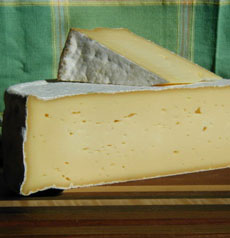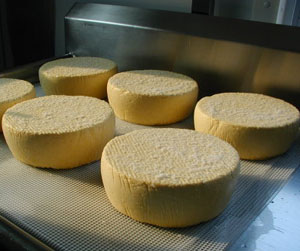

Menuet, the cheese, is named after minuet, the dance. Originating in France, this Menuet is made by Dancing Cow Cheese in Vermont.
|
DANA ROMERO is the owner of La Fromagerie D’Acadiana in New Iberia, Louisiana.
|
|
February 2009
|
 |
Menuet Cheese
Page 2: How The Cheese Is Made
This is Page 2 of a two-page article. Click on the black links below to visit Page 1.
How Menuet Is Made
The cheese is hand crafted, seven days a week, from fresh uncooled milk that flows directly from the cows in the milking parlor into the cheese vat. This age-old classic European technique allows Dancing Cow Farm to capture the freshest flavors of the current pasture. That’s why the cheese is seasonal: During the winter months when the herd is fed silage, the cheese won’t have the same wonderful flavor.
The cheese wheels are salted (see the photo below) and then sent to age in a temperature- and humidity-controlled ripening room, or cave. During its time in the cave, the cheese is washed, brushed and turned to nurture its development. Menuet is aged in the state-of-the-art cellars at Jasper Hill Farm, another maker of fine artisan cheese, for a minimum of five months, until its creamy texture and depth of flavor are at peak. Then it is ready for sale.
Cheese Terms
Here are cheese terms relevant to this article. For more cheese terms, see our Cheese Glossary.
Artisan Cheese: A cheese made in small batches, using traditional techniques—it refers to the manner in which the cheese is made. As little mechanization as possible is used in the production of the cheese.
Eyes: Eyes are holes in the cheese that are caused by gas that is trapped in the course of fermentation during the curing process. The eyes can range from pin size to the size of a dime or larger.
Farmstead Cheese: A cheese made on a farm from the milk of the farm’s animals—the term refers to the source of the milk and the location where the cheese is made. A cheese can be artisan, farmstead, or both. Dancing Cow’s cheeses are both.
Tome or Tomme: A French word for a particular rustic-style cheese native to the Haute Savoie region of France. The word precedes the names of certain cheeses, such as Tome de Savoie or Tome de Beaumont. Tomes are similar in style to the washed-rind cheeses produced in the monasteries of France.
*Prices and product availability are verified at publication but are subject to change. Shipping is additional. These items are offered by a third party and THE NIBBLE has no relationship with them. Purchase information is provided as a reader convenience.
Lifestyle Direct, Inc. All rights reserved. Images are the copyright of their respective owners.

|





